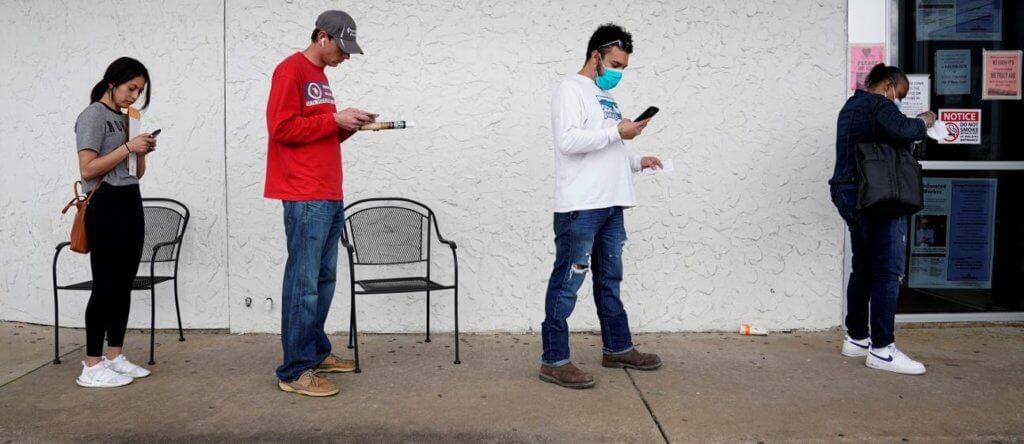
Photo by: Reuters
By David M. Dworkin
The economic crisis caused by the COVID-19 pandemic reached a new level this week as an additional 4.4 million Americans filed for unemployment insurance, driving the number of people who have lost their jobs to at least 26 million and the unemployment rate to an estimated 18%. Numerous states are struggling to process new applications and the actual numbers could be higher. Six weeks in, we have a long road ahead of us.
Yet, after an initial and relatively bold response, policymakers in Washington have pushed their heads deep into the sand, hoping against hope, that it will all get magically better. The Federal Housing Finance Agency provided much-needed clarity for mortgage servicers but has refused to provide the liquidity support necessary to help them get through the duration of the crisis. They should be encouraging mortgage servicers to give troubled borrowers the help they need now, but instead, they have forced them to kick the can down the road, doubling or tripling the amount of work necessary to provide lasting help to those who need it.
Likewise, the Treasury Department threw cold water on suggestions by the Federal Reserve Board that they might work together on creating a liquidity facility to support the mortgage market. Congress, in the meantime, has failed to pass comprehensive rental assistance, waiting for the crisis to escalate beyond the government’s ability to cope. Refusing to plan for the next phase of a crisis that is already upon us is a recipe for disaster. But it doesn’t have to be this way.
That’s why NHC is working with a wide range of housing leaders to help develop a comprehensive approach to rental assistance that will provide real help to both renters who lose their jobs and are not fully covered by unemployment insurance, as well as the apartment owners who still have to pay to keep buildings clean and operational. We don’t want people evicted at the end of the crisis because they followed social distancing guidelines or lost their jobs when their companies laid them off or went out of business.
Many of us have struggled with the question of how much worse this pandemic and its economic impact can get. It’s hard to think about, but it is essential to preparing for what is coming next. We have all heard about the wildly disparate models that predict the number of U.S. deaths from COVID-19. Some have suggested as few as 67,000 deaths by August – a model, where the low end has already been surpassed and the high end is over 123,000. Other estimates predict ranges much higher and broader. All of these models are dependent on the assumptions embedded in them, the most important of which is how well we all apply social distancing recommendations. As we have seen in Georgia, Florida, South Carolina and Texas, adherence will also have a very broad range of health and economic outcomes. In some states, those who insist on following federal guidelines for social distancing may risk losing unemployment benefits if they refuse to return to work.
We need to prepare for the worst-case scenario now, while hoping for the best. This week, we got an indication of what that scenario may look like. In a blog post at the Federal Reserve Bank of St. Louis, Miguel Faria e Castro predicted that by the end of the second quarter of 2020, the unemployment rate could exceed 32% — over 52 million Americans. The implications of such figures would be devastating for the housing economy and demand our immediate and full attention. It requires comprehensive planning for easily accessible rental assistance, mortgage loan payment deferrals and liquidity support for the apartment owners, mortgage lenders and loan servicers that will have to implement them.
Emergency rental assistance is essential to supporting the economic stability of millions of renters across the country who have been impacted by COVID-19. Failure to act will threaten the stability of our housing finance system and imperil thousands of small businesses and nonprofit organizations that own and operate rental housing properties across the United States. It will also lead to increased levels of homelessness and overcrowded housing conditions that will only serve to exacerbate our current public health crisis.
The first four relief bills sought to address the immediate crisis. A new bill, being discussed in Congress, will address mid-term needs. However, these efforts have struggled to find agreement on how much rental assistance is needed, given better than expected April rent payments and federal efforts to fund more generous unemployment benefits. But we can be certain that May payments will be dramatically worse, as will requests for mortgage forbearance, which already exceeds 6% of outstanding mortgages.
Failure to prepare for June of this year, and the many months to follow, is a recipe for disaster, but one that is avoidable if we act now.
David M. Dworkin is president and CEO of the National Housing Conference

